This is a case study of how we leveraged keyword research, topical authority, and site structure on CannabisSensei.com to increase Google organic traffic by 900% in 7 months.
Starting point:
This site only had around 100 published articles with no new content added for the past 18 months when we acquired it in December 2022 and started working on it.
The Results
Our team grew the organic traffic 10x from 60 clicks per day to 600 clicks per day in 7 months by doubling the number of articles on the site, expanding out into related topics, and reorganizing the site structure.
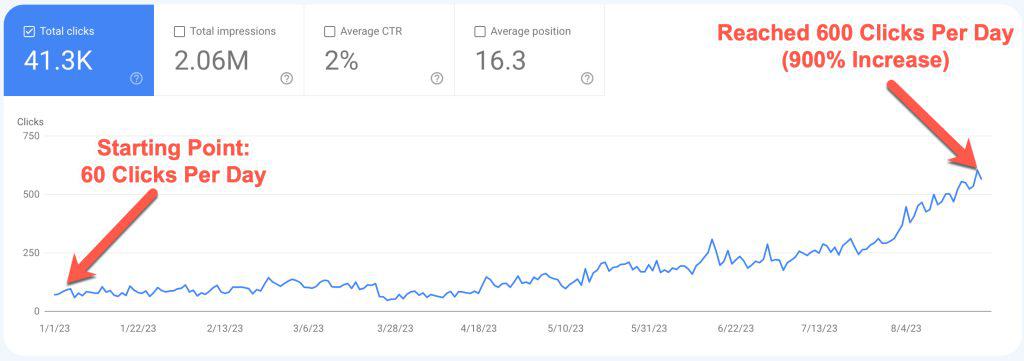
Our Growth Strategy
At the beginning of 2023, we started working on CannabisSensei.com, an abandoned content website with around 100 articles of marijuana strain reviews written by the original site owner who was a niche expert and enthusiast.
The site had no existing monetization, a weak backlink profile (DR2…), and hadn’t been updated in well over a year.
The existing content was exclusively on the topic of strain reviews, but after doing competitor and niche research we believed there was opportunity to expand into more profitable topics like seed bank reviews and grow equipment.
Even though the site had insignificant domain authority, since it was over 2 years old and still receiving consistent traffic of ~60 clicks per day without any content updates we hypothesized it had a good shot of ranking for new content on similar topics.
Our original plan was to keep publishing more strain reviews (to maintain consistency with the existing site) and start expanding into new, more lucrative content areas.
We also needed to overhaul the homepage, create category blog roll pages, and update the overall site structure/architecture to incorporate new content into the site.
Putting it Into Practice
We got to work to fully flesh out the content strategy.
Keyword Research
This involved identifying top competitors, assessing the competitiveness of the target keywords to determine which ones were feasible to rank for given our weak backlink profile, and setting the content calendar and publishing schedule.
For the new articles we prioritized topics that had the lowest competition (easiest to rank for) and the highest search volume (giving us more traffic).
Here is an example of the first strain review keywords we set out:
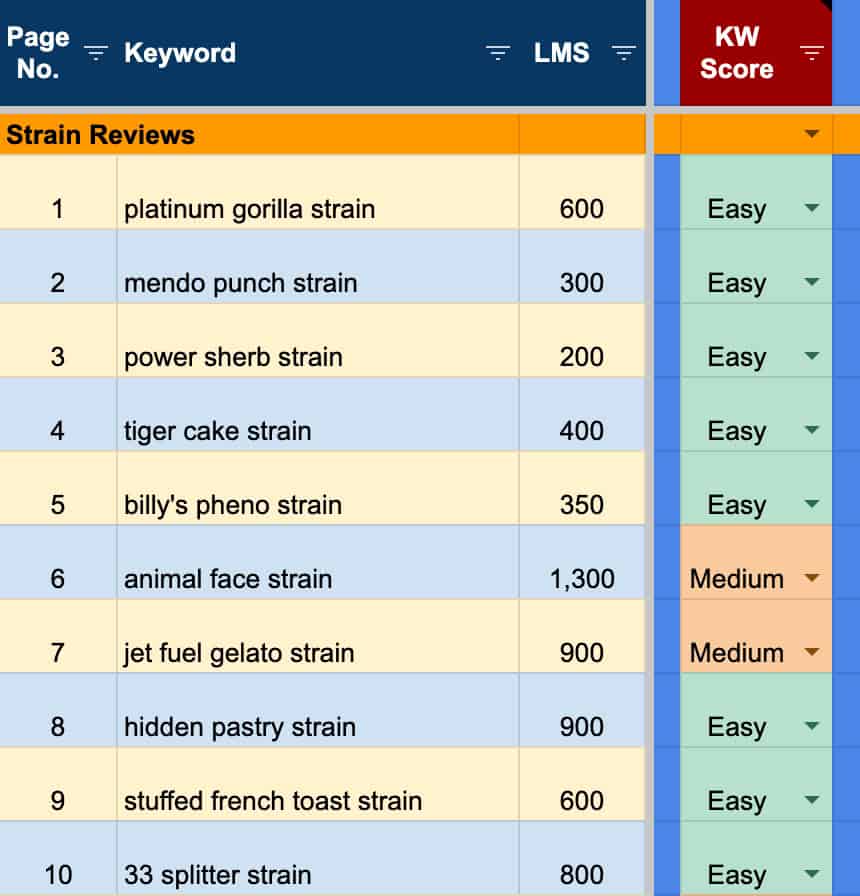
Article Outlines
We got to work to fully flesh out the content strategy.
This involved identifying top competitors, assessing the competitiveness of the target keywords to determine which ones were feasible to rank for given our weak backlink profile, and setting the content calendar and publishing schedule.
To increase the new content’s chance for success and to maintain consistency in the editorial quality, we created detailed article outlines for each article type.
For example, the existing strain reviews followed a similar style and structure, so we extracted the core elements and standardized them for each new article.
Here is a snippet from the new strain review article template:
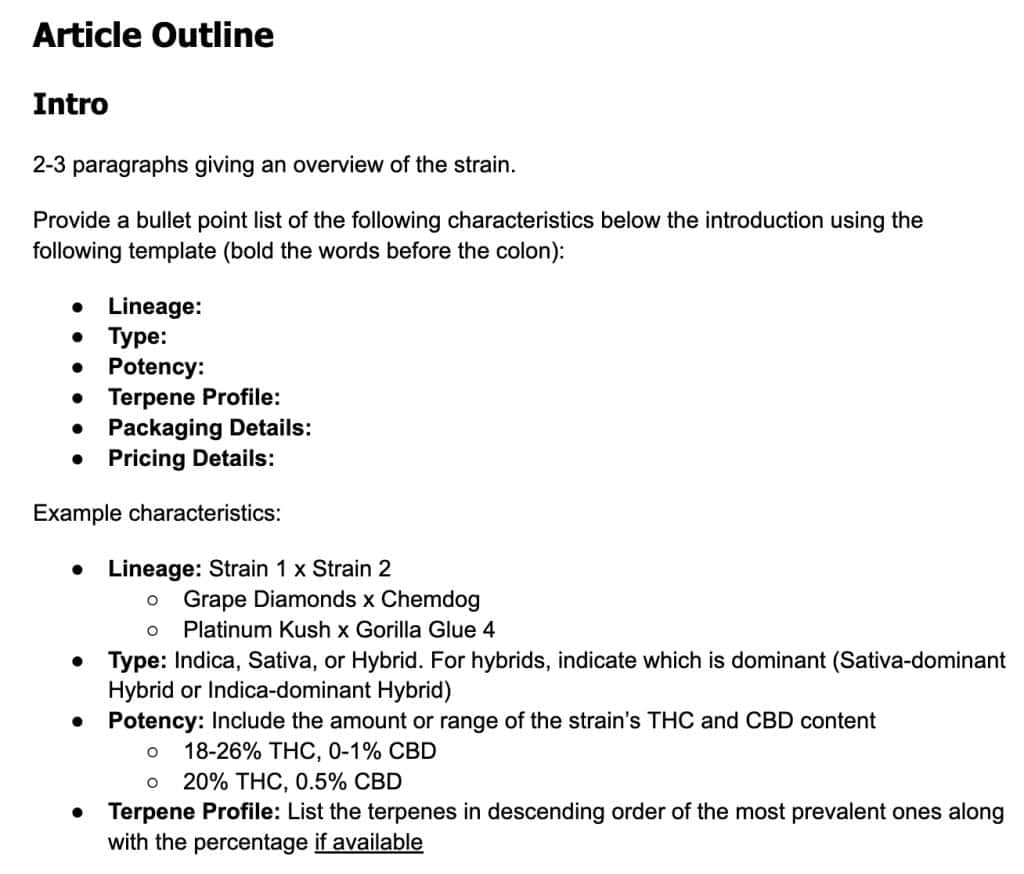
Rolling Out The Content Strategy
Here is a graph of the publishing cadence, showing how we published between 8-28 articles per month from March-September 2023 for a total of 103 new articles published. This doubled the amount of content on the site.
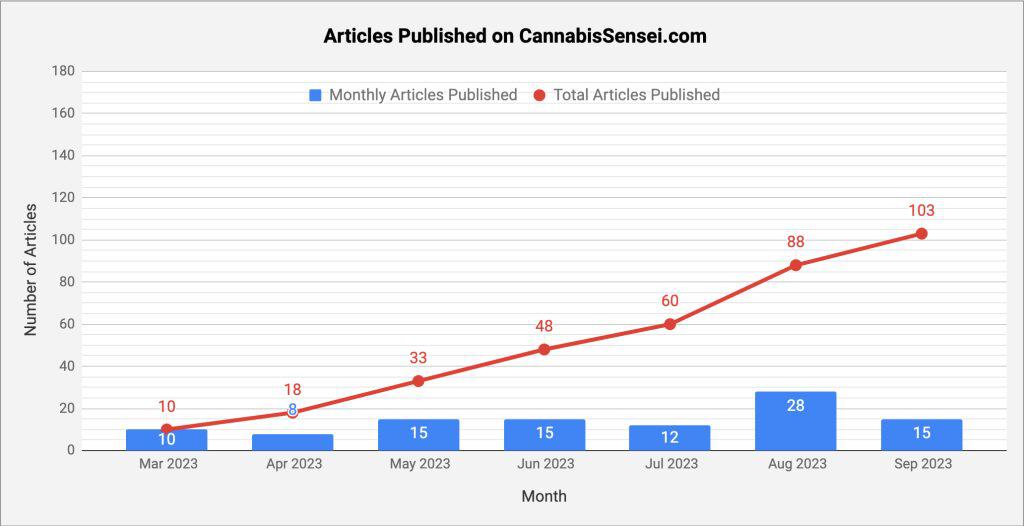
We primarily focused on publishing more strain review articles to maintain consistency with the existing base of content, and slowly started incorporating other content areas such as general cannabis information, seed bank reviews, and cannabis seed information.
Here is a breakdown of the articles published each month by category:
| Article Category | Mar 2023 | Apr 2023 | May 2023 | Jun 2023 | Jul 2023 | Aug 2023 | Sep 2023 |
| Strain Review | 6 | 8 | 15 | 10 | 8 | 9 | 3 |
| Cannabis Information | 4 | 0 | 0 | 1 | 2 | 9 | 1 |
| Seed Bank Review | 0 | 0 | 0 | 4 | 1 | 5 | 10 |
| Cannabis Seed Info | 0 | 0 | 0 | 0 | 1 | 5 | 1 |
| Total Published | 10 | 8 | 15 | 15 | 12 | 28 | 15 |
Other Site Enhancements
Link Building
From March-September we built a total of 14 backlinks (8 guest posts, 6 link insertions) to help build up the domain authority. We built 5 links to the homepage and 9 across various inner pages. The backlinks came from websites that ranged from DR27 to DR81 and had an average DR of 45.
We got paid link placements on 9 of the sites and got the other 5 backlinks for free by leveraging our existing relationships and doing some crafty A-B-C link exchanges.
Site Restructuring
Since we added new content categories we needed to update the homepage to add new sections for each category. This essentially consisted of adding a relevant subheading, a blog roll of the latest posts in the category, and a link to the main category page.
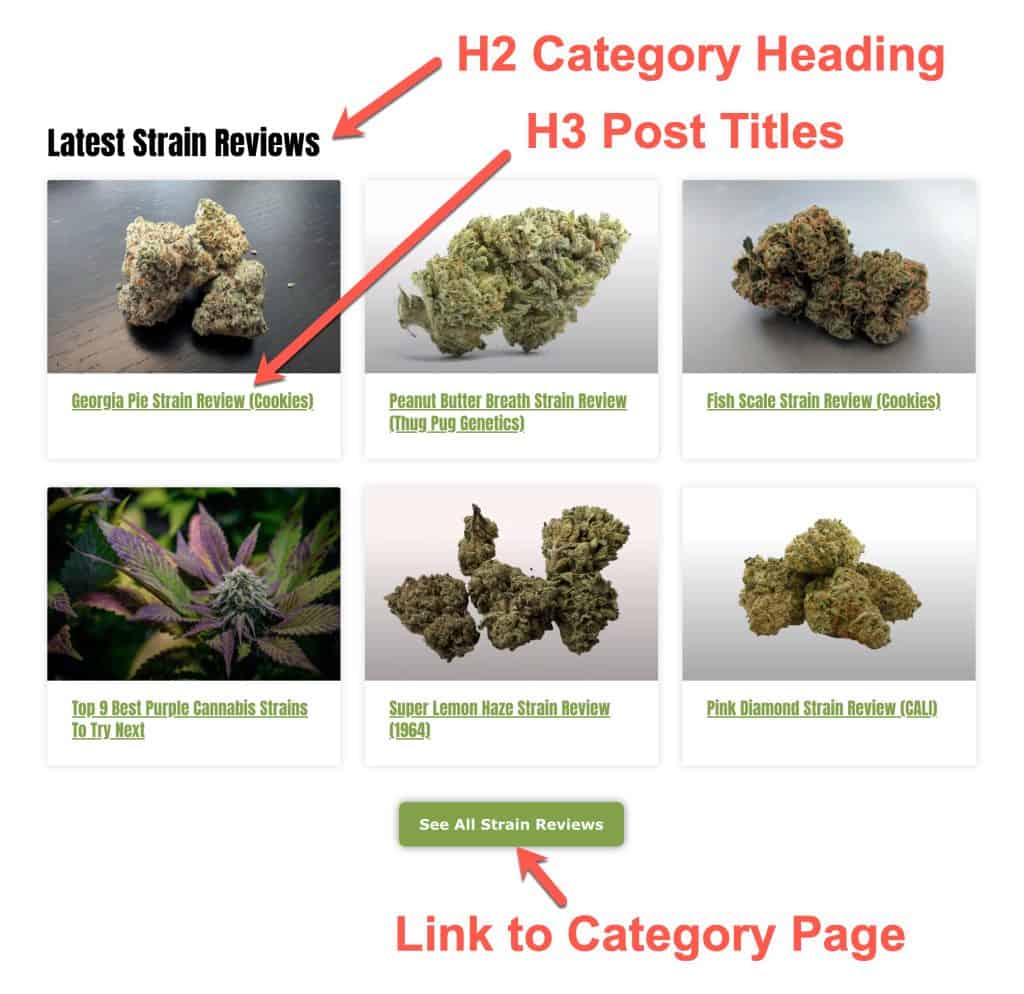
Speaking of category pages, we created new ones for each major category. The purpose of these category pages is to link to ALL of the posts in the category (unlike on the homepage which only shows a handful of the latest ones) so that every post on the site is only 2 clicks deep from the homepage.
Here is an overview of the Cannabis Seeds category page layout. The same structure is repeated for each subsection of cannabis seeds (best seed banks, where to buy seeds in X state/country, how to care for cannabis seeds, etc).
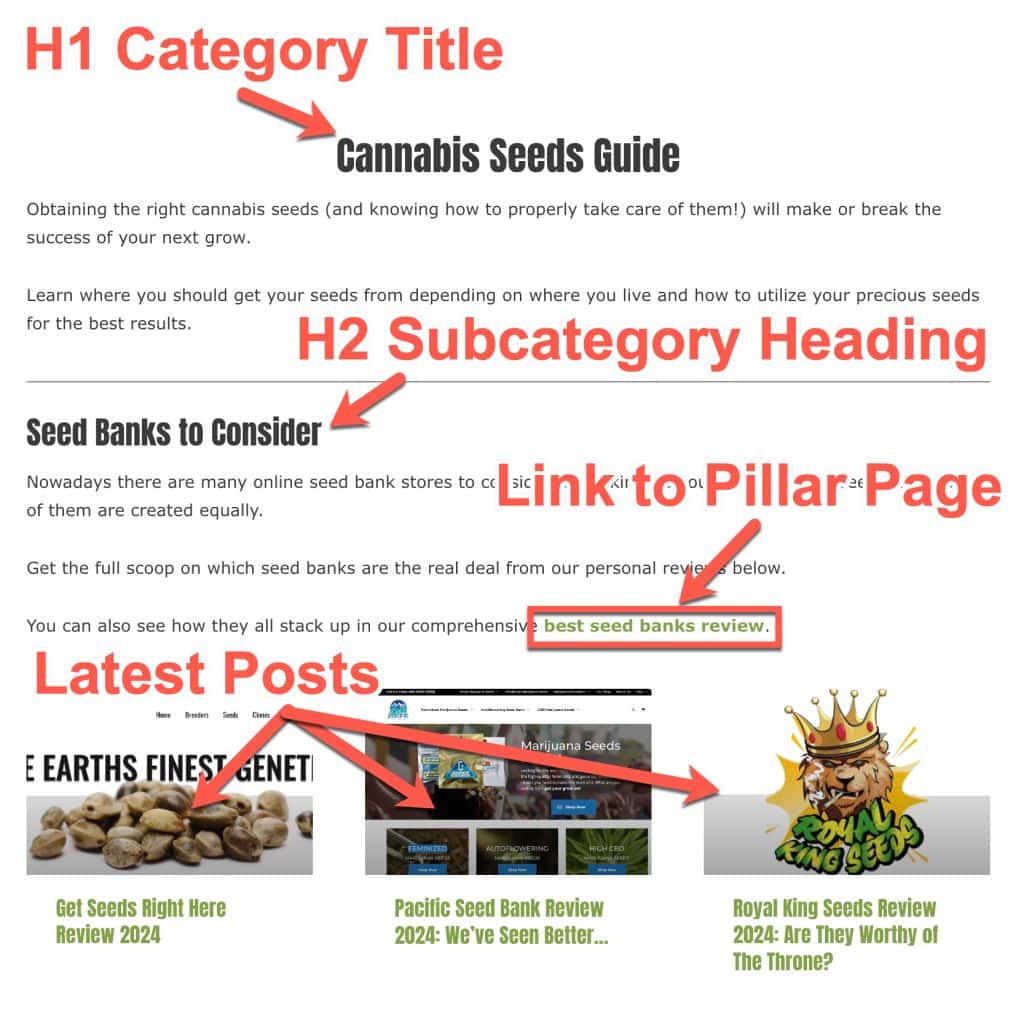
Internal Linking Updates
We applied a consistent, optimized internal linking strategy across the site for both new and existing content.
The goal of proper internal linking is to avoid orphan pages (pages with 0 incoming internal links) and to improve site crawlability for Google and site usability for readers.
Here is the internal linking diagram for the Cannabis Seeds category with examples and instructions for the publishing team:
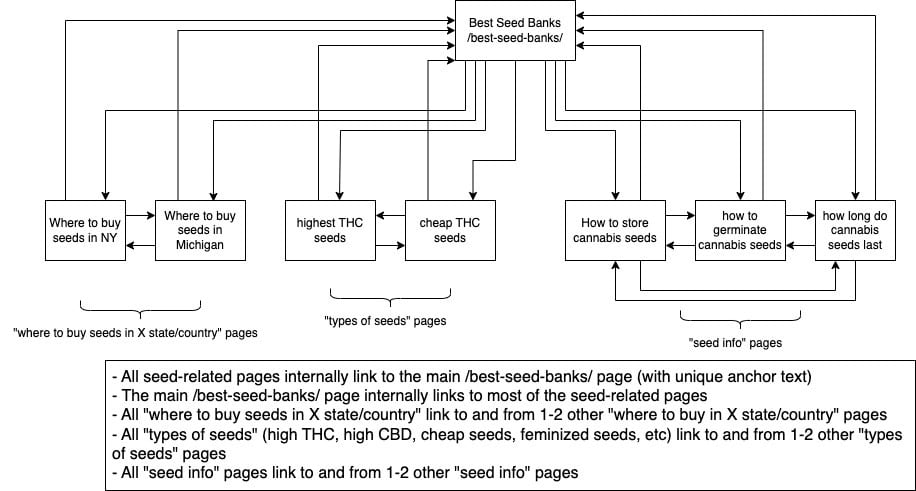
Summary
A tenfold increase in organic traffic is realistic with the right strategy and execution, even if a website has been untouched for over a year and the existing authority is nonexistent like in this case study when we started with just a DR2.
Here’s a summary of what worked here:
- Keep publishing more articles on the existing topics already doing well (in this case, cannabis strain reviews)
- Test out publishing articles on similar topics (“shoulder niches”) with more lucrative monetization opportunities—in this case, seed bank reviews and grow equipment reviews
- Create content templates to standardize article creation
- Update site structure, navigation, and internal linking to properly incorporate new categories and spread the “link juice” around
